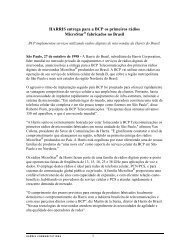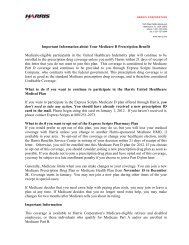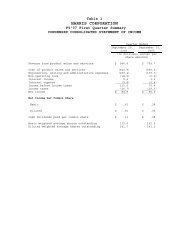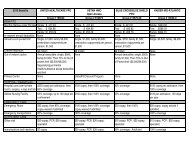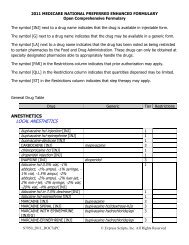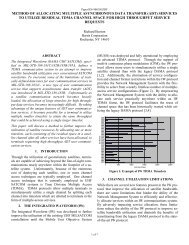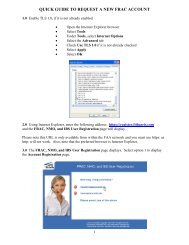harris corporation
harris corporation
harris corporation
Create successful ePaper yourself
Turn your PDF publications into a flip-book with our unique Google optimized e-Paper software.
Key Indicators<br />
We believe our value drivers, when implemented, will improve our key indicators of value, such as: income<br />
from continuing operations and income from continuing operations per diluted common share; revenue; income<br />
from continuing operations as a percentage of revenue; net cash provided by operating activities; return on average<br />
assets; and return on average equity. The measure of our success is reflected in our results of operations and<br />
liquidity and capital resources key indicators as discussed below:<br />
Fiscal 2011 Results of Operations Key Indicators: Income from continuing operations, income from<br />
continuing operations per diluted common share, revenue, and income from continuing operations as a percentage of<br />
revenue represent key measurements of our value drivers:<br />
• Income from continuing operations increased 4.7 percent to $588.0 million in fiscal 2011 from<br />
$561.6 million in fiscal 2010;<br />
• Income from continuing operations per diluted common share increased 7.5 percent to $4.60 in fiscal 2011<br />
from $4.28 in fiscal 2010;<br />
• Revenue increased 13.8 percent to $5.9 billion in fiscal 2011 from $5.2 billion in fiscal 2010; and<br />
• Income from continuing operations as a percentage of revenue decreased to 9.9 percent in fiscal 2011 from<br />
10.8 percent in fiscal 2010.<br />
Refer to MD&A heading “Operations Review” below in this Report for more information.<br />
Liquidity and Capital Resources Key Indicators: Net cash provided by operating activities, return on average<br />
assets and return on average equity also represent key measurements of our value drivers:<br />
• Net cash provided by operating activities increased to $833.1 million in fiscal 2011 from $802.7 million in<br />
fiscal 2010;<br />
• Return on average assets (defined as income from continuing operations divided by the two-point average of<br />
total assets at the beginning and ending of the fiscal year) decreased to 10.8 percent in fiscal 2011 from<br />
12.2 percent in fiscal 2010; and<br />
• Return on average equity (defined as income from continuing operations divided by the two-point average of<br />
equity at the beginning and ending of the fiscal year) decreased to 25.0 percent in fiscal 2011 from<br />
27.7 percent in fiscal 2010.<br />
Refer to MD&A heading “Liquidity, Capital Resources and Financial Strategies” below in this Report for more<br />
information.<br />
Industry-Wide Opportunities, Challenges and Risks<br />
Department of Defense: The DoD’s U.S. Government Fiscal Year (“GFY”) 2012 budget proposal reflects<br />
continued investment in national security priorities (including cyber security) and continues efforts to rebalance<br />
military forces to focus on both today’s wars as well as potential future conflicts. Building on efforts begun in GFY<br />
2010, the DoD will continue to implement its acquisition reforms and modernize key weapons systems to provide<br />
service members with the best technology to meet battlefield needs. We expect the U.S. Government to remain<br />
committed to funding intelligence, information superiority, special operations, warfighter support and cyber security,<br />
although there can be no assurance it will do so.<br />
The DoD’s $671 billion GFY 2012 budget request is approximately 3.1% less than GFY 2010 enacted levels of<br />
$692 billion and approximately 5.3% less than the $708 billion GFY 2011 budget request. The GFY 2012 budget<br />
request includes $553 billion for base defense programs compared with $549 billion for base defense programs in<br />
the GFY 2011 budget request, and includes $118 billion for overseas contingency operations (“OCO”) compared<br />
with $159 billion for OCO in the GFY 2011 budget request, reflecting the winding down of military operations in<br />
Iraq and Afghanistan. Of the $118 billion GFY 2012 budget request for OCO, $107 billion is to support activities in<br />
Afghanistan and $11 billion is to support activities in Iraq.<br />
The level of budget amounts allocated to DoD procurement accounts (“Procurement”), along with research,<br />
development, test and evaluation (“RDT&E”) components of the DoD budget, also are an important indicator of<br />
spending. The GFY 2012 budget requests for Procurement and RDT&E of $113 billion and $75 billion, respectively,<br />
are comparable to the GFY 2011 budget requests of $113 billion and $76 billion, respectively. Additionally, the<br />
DoD Operations and Maintenance account (“O&M”), which contains the bulk of funding for training, logistics,<br />
services and other logistical support, is an account of major importance. The DoD O&M budget request for GFY<br />
2012 is $204 billion compared with the GFY 2011 budget request of $200 billion.<br />
37




